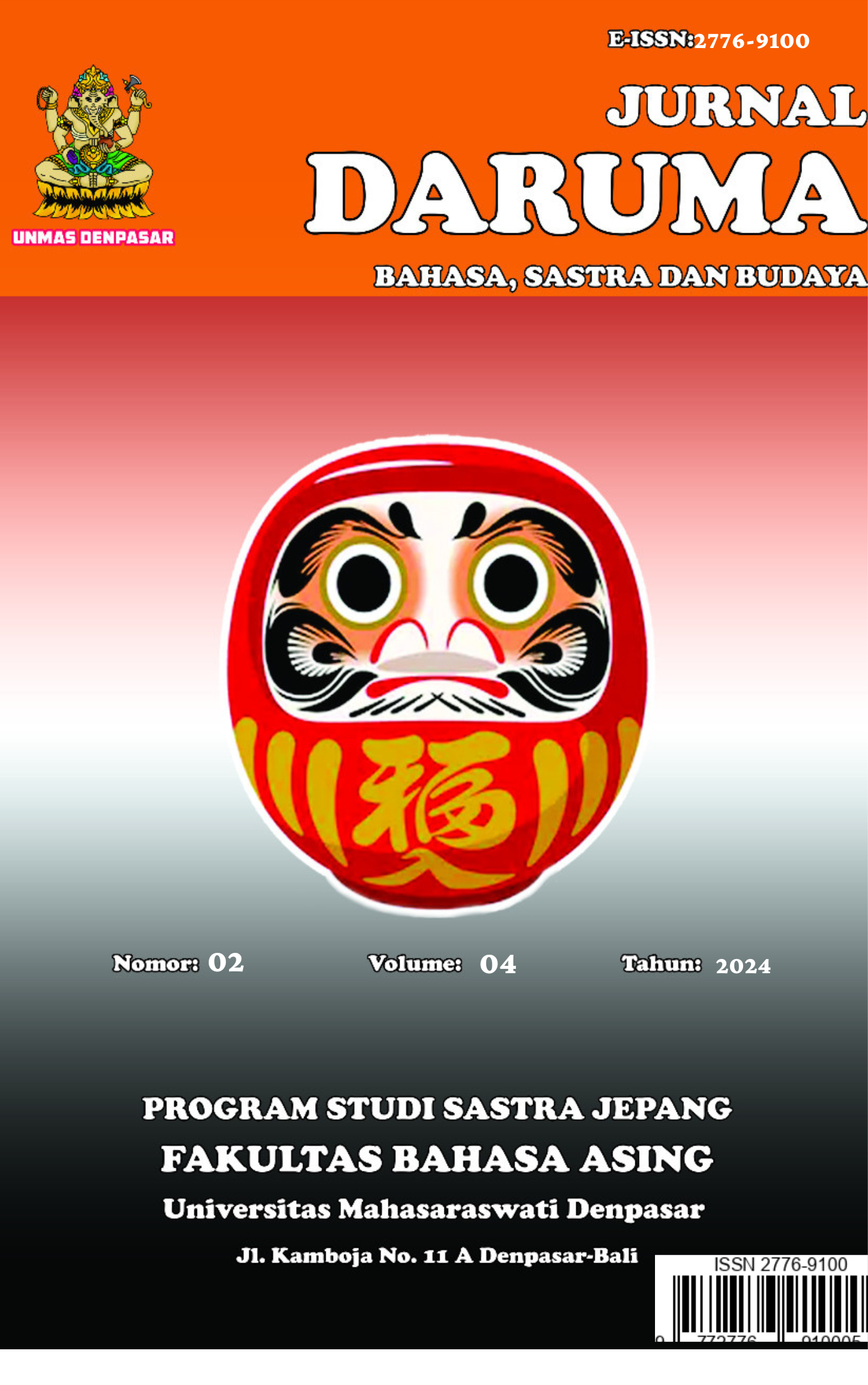NILAI – NILAI YANG TERKANDUNG DALAM IMPLEMENTASI BUDAYA KYUUSHOKU (MAKAN SIANG DI SEKOLAH)
Keywords:
Culture, School, KyuushokuAbstract
In Japan, education and culture are highly respected, leading to various systems in education that encourage learning not only focused on teaching and learning itself. Education in Japan emphasizes character development and social attitudes towards different cultures, as well as the formation of cultural identity. One such system is called Shokuiku, which is centered on learning about the origins of food, understanding nutritional values, and developing a positive relationship with food. Within Shokuiku, there is a school lunch program called Kyuushoku. The role of school lunches in the overall educational system opens a deeper dimension to explore how food education and culture interrelate and shape a unique cultural identity. Therefore, this research aims to understand the values contained in the implementation of Kyuushoku culture. The theory used in this research is the Structural Functional Theory according to Talcott Parsons. The methods employed by the author include library research and field studies, sending surveys via Google Forms online to the Japanese community that has participated in Kyuushoku as supporting data sources. The results of this study indicate that Kyuushoku culture carries values such as: Nutrition and Health, Cooperation and Helping Each Other, Togetherness, and Environmental Awareness.
References
Adnyana, K. S. (2021). BUDAYA KYUUSHOKU SEBAGAI PEMBENTUKAN KARAKTER ANAK JEPANG. Fakultas Bahasa Asing Universitas Mahasaraswati (pp. 5-30). Denpasar: eprints.unmas.ac.id.
Asakura, K., & Sasaki, S. (2017). School lunches in Japan: their contribution to healthier nutrient intake among elementary-school and junior high-school children. Public Health Nutrition, 20(9), 1523–1533. doi:10.1017/S1368980017000374
Furushima, S., & Kneko, K. (2006). The study of dietary behavior at school lunch of the first-grade primary school children. Journal of the Faculty of Education and Human Science, Yokohama National University, Educational Science, 8, 15–31. http://hdl.handle.net/10131/1634
Hoogvelt, Ankie M.M. (1995). Sosiologi Masyarakat Sedang Berkembang. Jakarta: Raja Grafindo Persada.
Ishida, H. (2018). The History, Current Status, and Future Directions of the School Lunch Program in Japan.The Japanese Journal of Nutrition and Dietetics, 76(Supplement), S2–S11. https://doi.org/10.5264/eiyogakuzashi.76.s2
Maruyama, H., Kato, K., & Nishimura, T. (2009). Kissyokujyokyo ga kodomo no syokuji ni ataeru eikyo [The influence of eating situation on children’s meals.]. Bulletin of Home Economics Department, Aichi University of Education, 39, 15−28.
http://hdl.handle.net/10424/3186
Morimoto, K., & Miyahara, K. (2018). Nutritional management implemented at school lunch programs in Japan based on the changes in criteria for provision of school lunches. The Japanese Journal of Nutrition and Dietetics, 76, Issue Supplement, S23–S37. doi:10.5264/eiyogakuzashi.76.S23
Nozue, M., Jun, K., Ishihara, Y., Takeda, Y., Nagai, N., Yoshita, K., & Ishida, H. (2010). Differences in food consumption and distribution of meals between the days with or without school lunches among 5th grade elementary school students. Japanese Journal of Nutrition and Dietetics, 68(5), 298–308. doi:10.5264/eiyogakuzashi.68.298
Regi, M., Razaqa, R., & Haryanti, P. (n.d.). NNA Putri & SM Setiana RAMEN DAN PRESENTASI IDENTITAS BUDAYA JEPANG.
Rosliana, L. (2017). SHOKU BUNKA: WARNA BUDAYA DAN TRADISI DALAM MAKANAN JEPANG, 6(2).
Sugiyono. (2013). Metodelogi Penelitian Kuantitatif, Kualitatif Dan R&D. Bandung: ALFABETA.
Sugiyono. (2019). Metode Penelitian Dan Pengembangan Research Dan Development. Bandung: Alfabeta.
Tatematsu, Y. (2008). The attitudes toward local dishes and dietary life: A survey of the fifth-grade elementary school children in Oita Prefecture. Bulletin of Beppu University Junior College, 27, 137–157. https://ci.nii.ac.jp/naid/110007043843
Waida, Y., & Kawamura, M. (2022). JAPANESE SCHOOL LUNCH AND FOOD EDUCATION. In School Food, Equity and Social Justice: Critical Reflections and Perspectives (pp. 171–186). Taylor and Francis.
Yamashita, A., Kaneko, R., Iso, S., & Kawamura, M. (2013). Practice and effect of pair lunch: Through “eating together one’s pair” between different grades. Journal of Integrated Center for Clinical and Educational Practice, Saitama University, 12, 119–123. doi:10.24561/00016304





